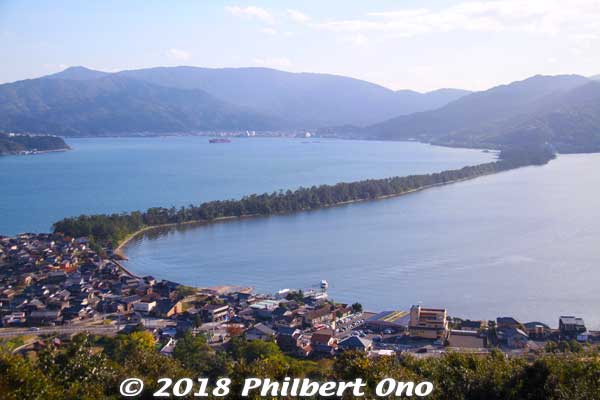
by Philbert Ono, updated Feb. 19, 2024
“Kyoto by the Sea” (海の京都) is a tourism catch phrase for northern Kyoto Prefecture that mainly faces the Sea of Japan. This region is most famous for Amanohashidate (天橋立), Ine fishing boat houses, Tango Peninsula, Tango chirimen silk fabrics, Kurotani washi paper, Maizuru navy town, and the castle town of Fukuchiyama.
For a few days in October 2018, I visited most of the major sights in northern Kyoto Prefecture and really enjoyed Kyoto away from the city of Kyoto.
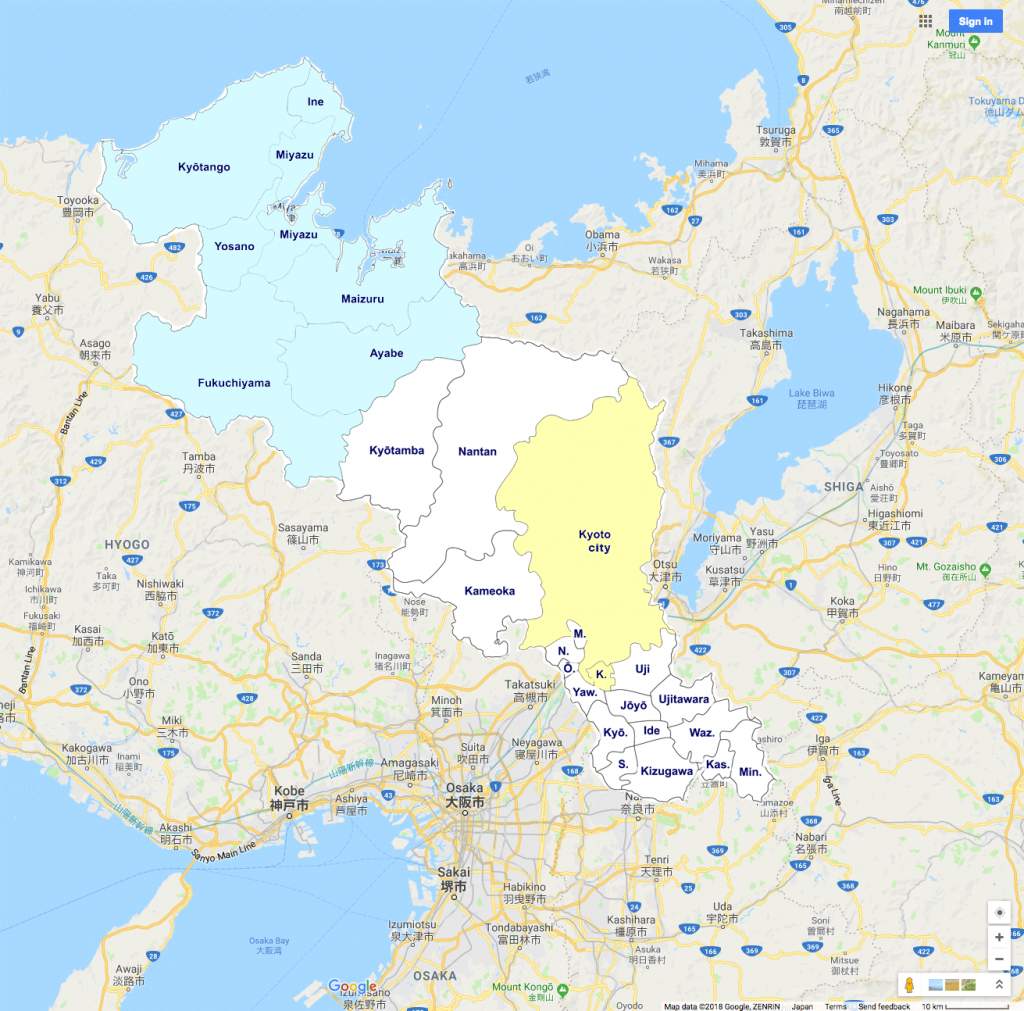
Above is a map of Kyoto Prefecture’s municipalities. Shaded in aqua are the seven municipalities in northern Kyoto Prefecture that have banded together under the “Kyoto by the Sea” PR name: Ayabe, Fukuchiyama, Ine, Kyotango, Maizuru, Miyazu, and Yosano (綾部市、福知山市、伊根町、京丹後市、舞鶴市、宮津市、与謝野町). The city of Kyoto is in yellow.
Northern Kyoto is about 2 hours north of JR Osaka Station and Kyoto Station via express train. Main gateway stations are Fukuchiyama and Amanohashidate Stations. The private Kyoto Tango Railway is the main train network in Kyoto by the Sea.
Kyoto Prefecture also has at least two other tourism PR themes: “Kyoto in the Forests” (森の京都) and “Kyoto Infused with Tea” (お茶の京都). They are outside the tourist-crowded city of Kyoto. The areas outside Kyoto city have a tougher time to attract tourists since most tourists just stay in the city of Kyoto.
So it’s a good strategy to promote tourism collectively in each region outside Kyoto city. For multiple municipalities to band together to promote their region under a central theme is still kind of rare in Japan. Hope they will be able to attract more tourists and relieve the crowds in Kyoto city.
Amanohashidate, Bridge from Heaven
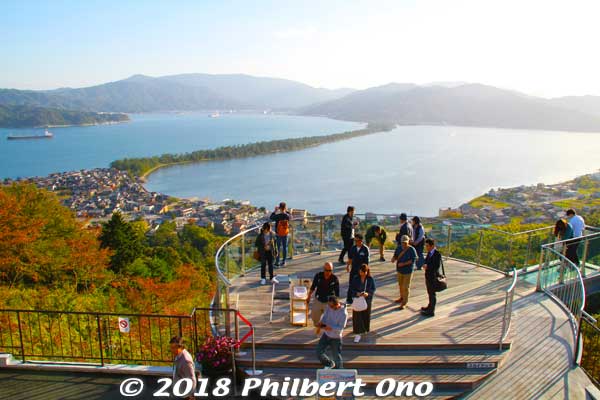
Amanohashidate (天橋立) is a narrow sandbar across the ocean from mainland Japan (city of Miyazu) to Tango Peninsula. It’s about 3.6 km long, totally flat, and you can cross it on foot or by bicycle (rentals available) on a dirt road in the middle. The road is lined with thousands of Japanese pine trees and closed to vehicular traffic. The above view is from the northern end (Kasamatsu Park). Location: https://goo.gl/maps/Ag5g2tBprcQ2

Nihon Sankei, Japan’s Scenic Trio
Amanohashidate has been one of Japan’s most famous tourist sights for centuries, well known as one of the Nihon Sankei (日本三景) or “Japan’s Scenic Trio.” (There’s no official English translation of Nihon Sankei, but I like to call it “Scenic Trio” in English. I like the word “trio” because it implies that they belong to a group of three. I don’t like what English Wikipedia calls it: “Three Views of Japan.”)
The other two Scenic Trio sites are Miyajima (vermillion torii and shrine on the ocean) in Hiroshima Prefecture and Matsushima (pine tree islands) near Sendai, Miyagi Prefecture.
So who decided that these three scenic sights were Japan’s Best Three? And Japan has so many of these “Best Three” or “Big Three” designations and Nihon Sankei is the most famous of them all. But why is it always “three?”
According to Japanese Wikipedia, Nihon Sankei originated in 1643 by Hayashi Gaho (aka Hayashi Shunsai), a Japanese Neo-Confucian scholar who wrote a book mentioning these three sights. The expression “Nihon Sankei” was later coined in 1689 by another Japanese Neo-Confucianist scholar, Kaibara Ekken in his travel diary. So “Nihon Sankei” goes way back to the 17th century.
It’s really amazing that it has stuck throughout these centuries even with Mt. Fuji excluded. With Japan having so many places of beauty, it would be nearly impossible for anyone today to unilaterally declare any three sights as the “Best Three.”
To the question of why the best always comes in threes, the answer seems to be more complicated. It seems the Japanese have had favorite numbers for many centuries. Many odd numbers are favored including one, three, five, and seven. This might sound familiar when you think about haiku and tanka poetry syllables, and the 7-5-3 (shichi-go-san) coming-of-age celebration for kids. But the number “three” for “Best Three” or “Big Three” has also stuck for centuries and still today.
Amanohashidate’s varying views
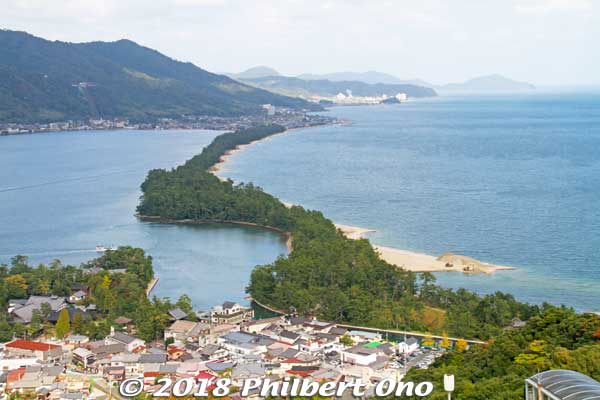
The thing about Amanohashidate is that it looks very different from different lookout points. The most popular spots to view Amanohashidate are on the hilltop on the southern and northern ends. If you have time, I highly recommend that you see it from both the southern end and northern ends. Which means you should rent a bicycle and ride across Amanohashidate which I also highly recommend.
As seen from the southern end above, the left side is the west side with an enclosed, but connected ocean named Asoumi Sea. The right side is the east side with white-sand beaches facing the open ocean. Ships can still go through both sides of the sandbar through a narrow strait on the southern end.
On the lower right of the sandbar, notice the finger of sand extending into the ocean. This finger keeps growing as the northern sand erodes and drifts south to the finger. So every few years, they have to remove the excess sand. (Notice the power shovel and dump truck working on it.) Otherwise, this little sand spit will become another sandbar across the ocean, impeding local shipping.
The hilltop on the southern end has a small amusement park called Amanohashidate Viewland easily accessible via chair lift or cable car, and a short walk from Amanohashidate Station.
Map: https://goo.gl/maps/yNhxjwK2ocz
Amanohashidate Viewland (southern end)
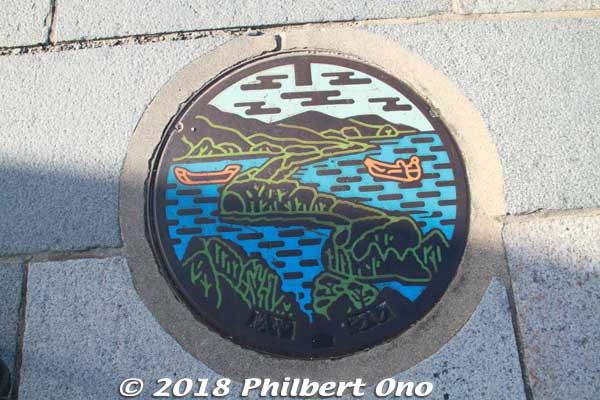
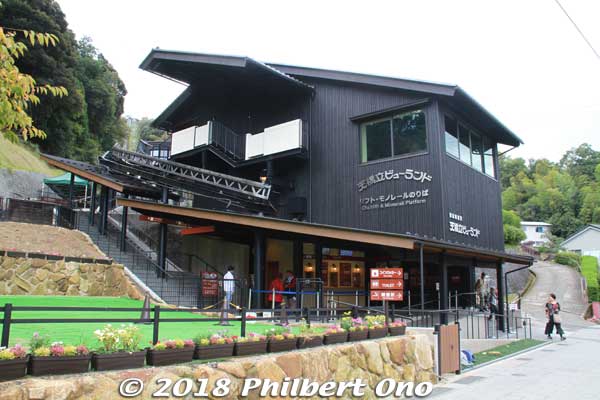
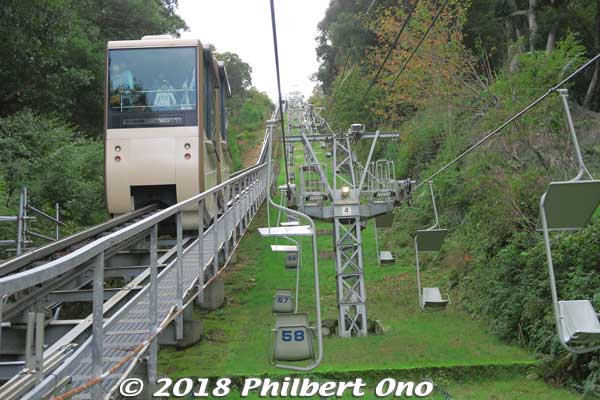
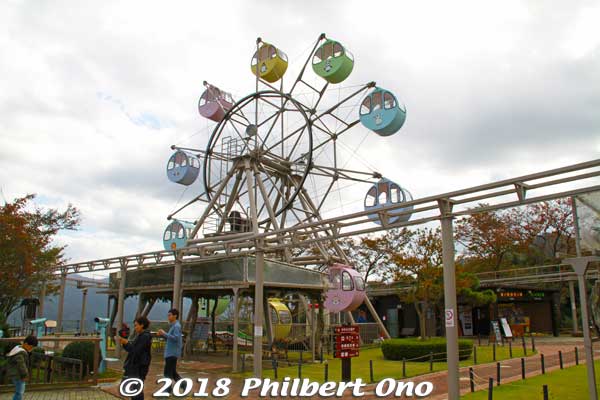
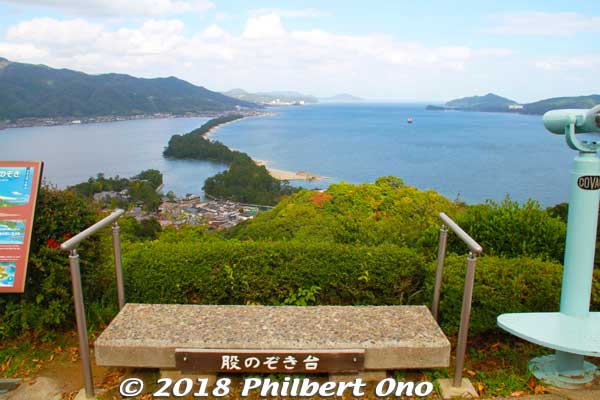
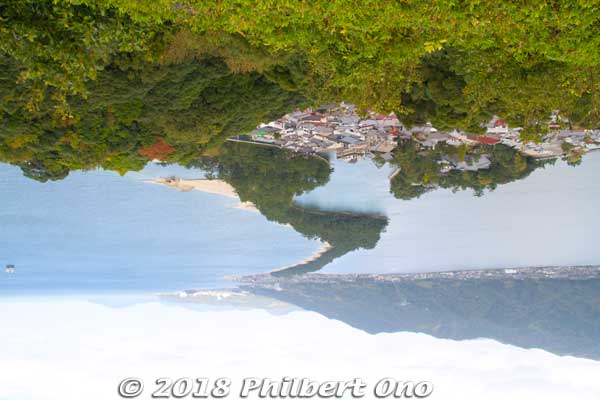
On the southern end here, Amanohashidate upside down does look like a flying dragon (hiryu 飛竜). That’s the dragon’s head in the front and the slim tail in the back. When you see it upside down, the sandbar/dragon is in the sky right?

Amanohashidate also has these “Circle of Wisdom” everywhere. To gain wisdom, you supposed to crawl or look through it three times or buy and throw three small clay dishes through it. Tourist gimmick.
Chionji Temple
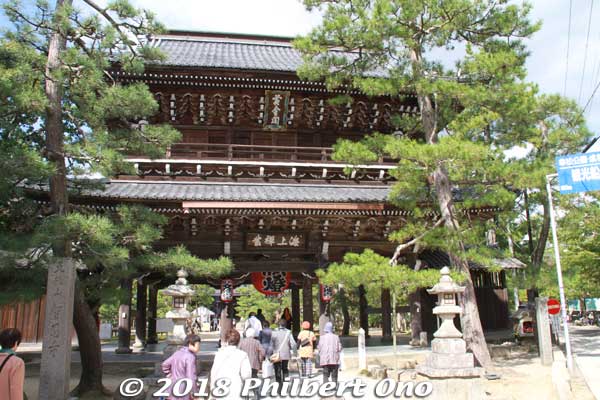
Before crossing Amanohashidate, stop by Chionji Temple (智恩寺) next to Amanohashidate’s southern entrance. With the imposing Sanmon Gate, you can’t miss it. Belonging to the Rinzai Zen Sect, Chionji worships the Manjushri bodhisattva (Monju Bosatsu) for wisdom and academic abilities. Many students pray here. The temple is not affiliated with Chion-in Temple in Kyoto city.
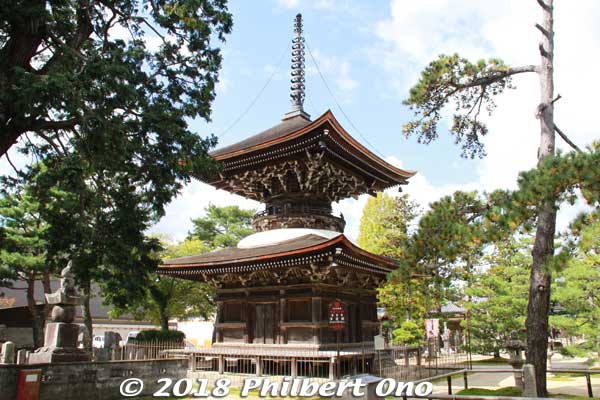
The temple’s beautiful Tahoto Pagoda with a round upper story and square lower story. It contains objects of worship.
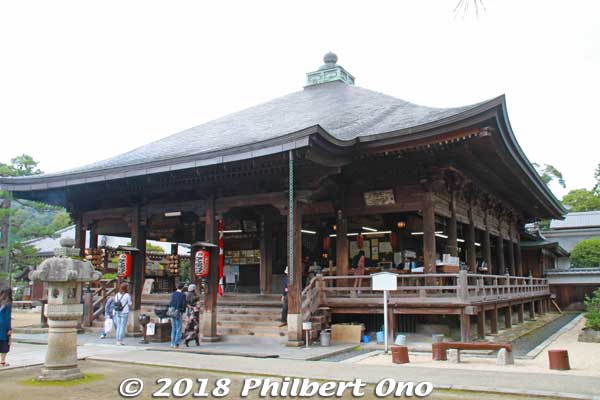
Chionji location: https://goo.gl/maps/Anjk19rRLzT2
Official site: https://www.monjudo-chionji.jp/
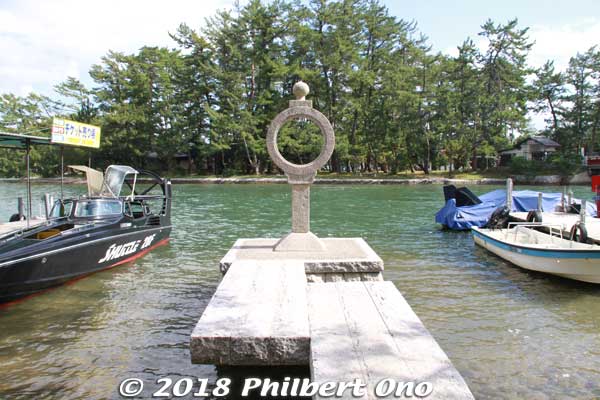
Next to Chionji Temple is this Circle of Wisdom Lantern (智恵の輪 灯籠). No longer a lantern to guide ships, but this is the original Circle of Wisdom in Amanohashidate that has been copied everywhere. Across the water is the Amanohashidate sandbar.
Crossing Amanohashidate
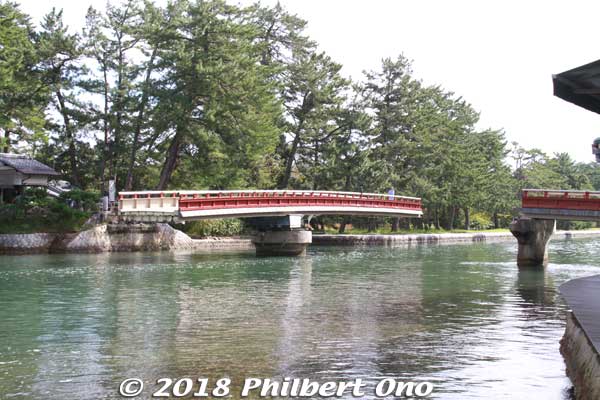
It takes about 15 min. to cross Amanohashidate by bicycle without stopping. But there are a number of monuments, a shrine, pine trees, and sandy beaches to photograph along the way. So it took me 30-40 min. to cross. Amanohashidate has wedded pine trees (夫婦松) and other fantastically-shaped pine trees and commemorative pine trees (planted by so-and-so emperor, etc.).
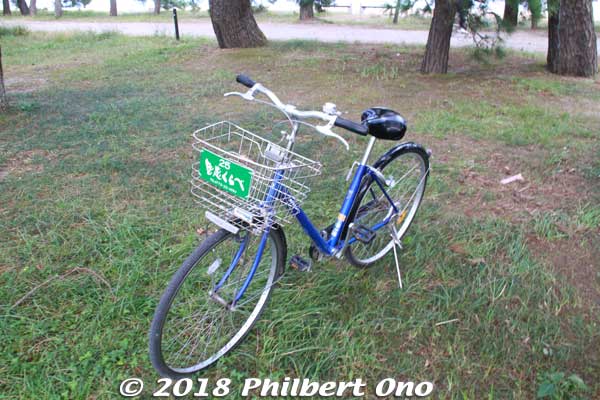


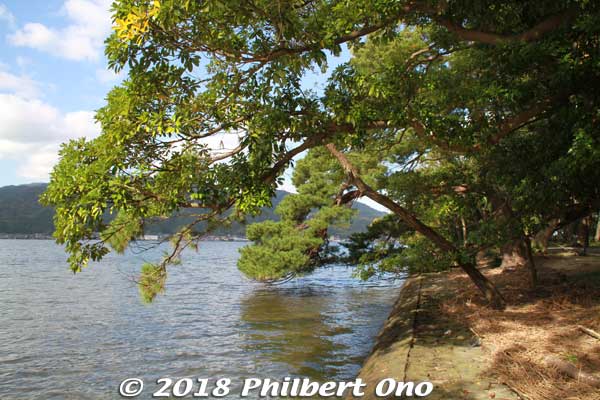
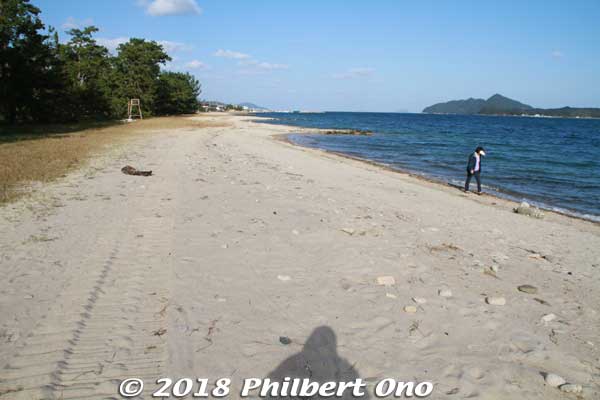
Moto-Ise Kono Shrine
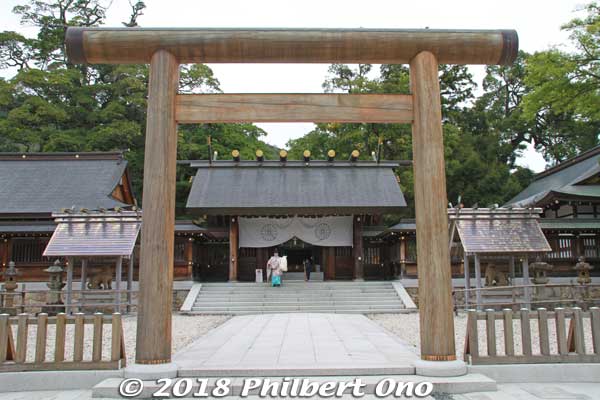
After crossing the sandbar, visit Moto-Ise Kono Shrine (元伊勢籠神社).
To understand this shrine, you need to know about Ise Grand Shrines (Ise Jingu) in Mie Prefecture, Japan’s most sacred Shinto shrines. They are dedicated to the Sun Goddess Amaterasu-Okami (Shinto’s most important goddess and legendary ancestor of the Imperial family) and Toyouke-Okami (豊受大神), goddess of agriculture.
Before Ise Jingu was established around the 7th century (or earlier), a number of shrines for these two deities were temporarily or permanently established in various locations including this Kono Shrine. These pre-Ise Jingu shrines are prefixed with “Moto-Ise.” Moto-Ise Kono Shrine worships five gods and one of them is Toyouke-Okami (豊受大神), the same goddess of agriculture worshiped in Ise.
The shrine is open 7:00 am to 5:00 pm. Free admission. The shrine is near the chair lift and cable car station (Fuchu Station) for the hilltop Kasamatsu Park (see below) for fine views of Amanohashidate from the northern end.
Address
Moto-Ise Kono Shrine
430 Ogaki, Miyazu-shi, Kyoto
〒629-2242 京都府宮津市字大垣430
Phone: 0772-27-0006
https://www.motoise.jp/
Map: https://goo.gl/maps/cDrgez7Zar32
Directions to Moto-Ise Shrine
By bus: At Amanohashidate Station (Kyoto Tango Railway), take a local bus bound for Ine, Kamanyu, or Kyogamisaki ([伊根・亀島] [蒲入] [経ヶ岬]) and get off at Jinja-mae stop. Parking also available.
By bicycle: Bicycles can be rented at a souvenir shop In front of Amanohashidate Station and at the entrance of Amanohashidate sandbar. Bicycle across Amanohashidate to the other end. Otherwise, walking from Amanohashidate Station will take at least 45 min.
Kasamatsu Park (northern end)

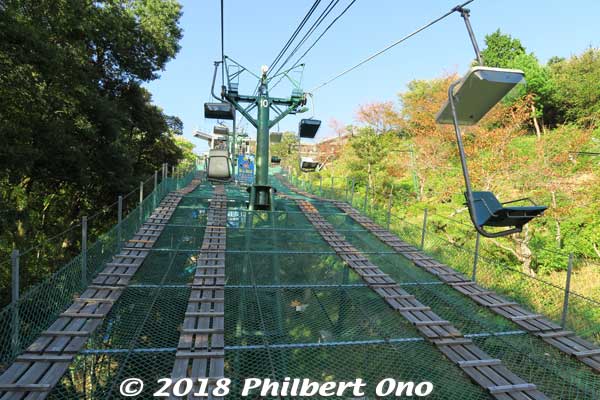
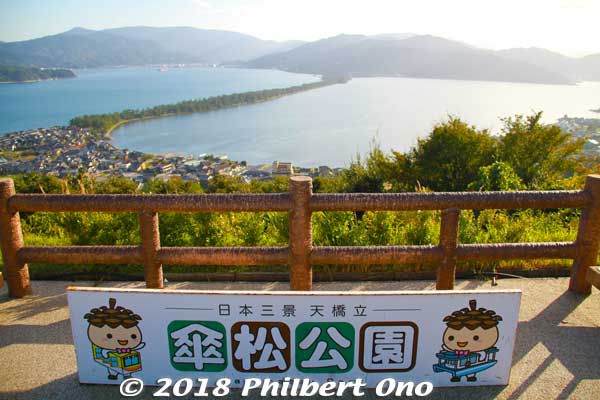


Amanohashidate is a sandbar created since thousands of years ago by opposing ocean currents carrying sand. But according to Japanese mythology, Amanohashidate was created during the divine Age of Gods (before man appeared). The great creator god Izanagi in Heaven, built a long floating ladder-bridge from Heaven to Earth so he could see his wife (younger sister) the goddess Izanami who was living at Moto-Ise Kono Shrine on Earth. However, in a single night while he was asleep, the bridge collapsed and fell to Earth, where Amanohashidate is today. And so if you view it upside down at Kasamatsu Park, it’s supposed to look like a bridge to/from heaven which is what “Amanohashidate” (天橋立) means.
And so Amanohashidate symbolizes a link between Heaven and Earth and between two lovers. That’s why you may also see heart or love symbols at Amanohashidate.
Address
Kasamatsu Park
Ogaki 75, Miyazu-shi, Kyoto
京都府宮津市大垣75
Phone: 0772-27-0032
English: https://www.amanohashidate.jp/lang/en/spots/kasamatsu-park/
Directions
By bicycle: Bicycles can be rented at a souvenir shop in front of Amanohashidate Station and at the entrance of Amanohashidate sandbar. Bicycle across Amanohashidate to the other end. Otherwise, walking from Amanohashidate Station will take at least 55 min.
By bus: At Amanohashidate Station (Kyoto Tango Railway), take a local bus bound for Ine, Kamanyu, or Kyogamisaki ([伊根・亀島] [蒲入] [経ヶ岬]) and get off at Amanohashidate Cable-shita stop [傘松ケーブル下]. Note that buses do not run that often. Bus schedule in Japanese: https://www.tankai.jp/routebus/
Amanohashidate Cable Car / Chair Lift (Fuchu Station)
Take the chair lift or cable car to go up to Kasamatsu Park.
Round trip: ¥660 for adults, ¥330 for kids (age 6 to 11). Price is the same whether you take the cable car or chair lift.
Hours: 8:00 am–5:30pm (till 4:30 pm or 5:00 pm during Nov.–Mar.)
Kasamatsu Park location: https://goo.gl/maps/QCK8o38yT3n
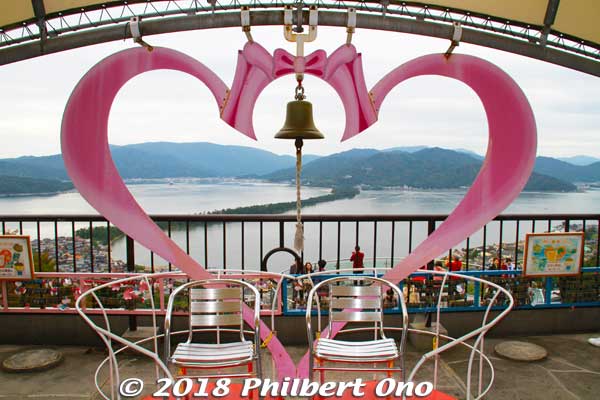
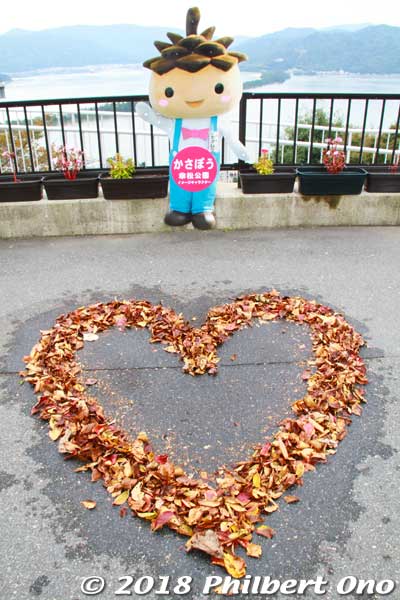
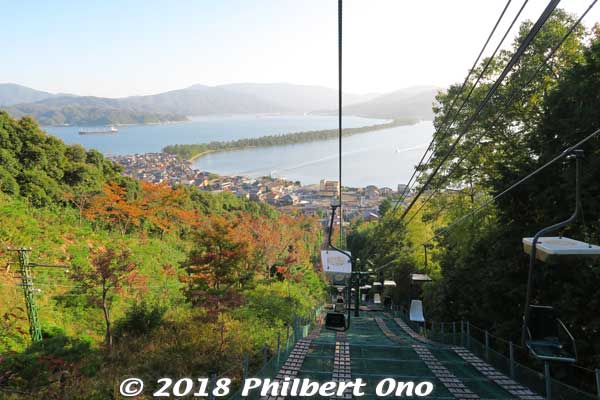
Amanohashidate is thus the symbol of northern Kyoto and Kyoto by the Sea. It’s less crowded, slow-paced, and very scenic. One of Japan’s Big Three Sceneries, Best Three Picturesque Views, Big Three Sights, or Scenic Trio. Whatever you call it, it’s famous in Japan.
More photos of Amanohashidate: https://photoguide.jp/pix/thumbnails.php?album=920
Transportation to and within Kyoto by the Sea (northern Kyoto)
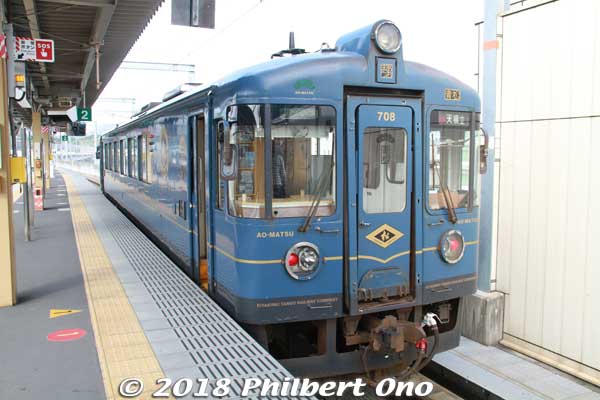
Express trains (tokkyu) from JR Osaka Station and JR Kyoto Station take 2 to 3 hours to reach northern Kyoto’s gateway train stations at Fukuchiyama, Miyazu, and Amanohashidate Stations. A few early morning trains go directly from Osaka/Kyoto to Amanohashidate. Other express trains will require you to transfer trains at Fukuchiyama or Miyazu Station to reach Amanohashidate Station. Fukuchiyama Station connects to the private Kyoto Tango Railway and JR San’in Line.
Kyoto Tango Railway (Kyoto Tango Tetsudo 京都丹後鉄道) is the main train network in northern Kyoto. (JR Railpass is not accepted.) Many places of interest are near a Kyoto Tango Railway train station. The trains usually have only one to three cars. From Fukuchiyama, you can get to Maizuru, Miyazu, Amanohashidate, and even Toyooka in Hyogo Prefecture. If you plan to ride Kyoto Tango Railways for a long distance, the one-day train pass is a good deal. Kyoto Tango Railway is operated by Willer Trains, a subsidiary of Willer Express that operates long-distance buses in Japan.
At Fukuchiyama Station, Kyoto Tango Railways operates a special tourist train named “Aomatsu” to Amanohashidate. It’s just one train car with a striking, wood-themed interior design. The floor and seat are made of wood. It has a bar for refreshments and a waitress. It’s a cafe train that serves drinks and light meals. As of this writing, the Aomatsu train runs once every morning (10:17 am) and afternoon (3:17 pm) from Fukuchiyama Station to Amanohashidate Station and requires no reservations nor extra train fare. Non-reserved seating. Aomatsu has a variety of seating arrangements like sofas, counter seating, and table seating (train fare is the same for all seats).
https://trains.willer.co.jp/matsu/aomatsu.html
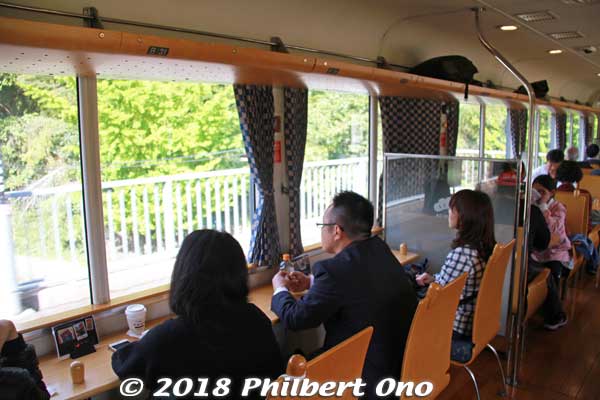
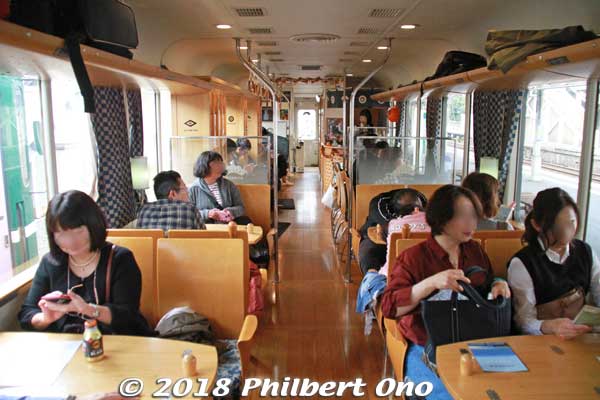
There’s also the “Kuromatsu” restaurant train that runs from Fukuchiyama to Amanohashidate Station on Fri., Sat., Sun., and national holidays. You can order a full dinner or confections or sake. The train fare includes the meal or drinks and obviously will be much more expensive than regular train fare. https://trains.willer.co.jp/matsu/
Kyoto Tango Railway has another cafe train named “Akamatsu” that runs twice a day (except on Tue. and Wed.) between Nishi-Maizuru and Amanohashidate. But this train requires reservations.
https://trains.willer.co.jp/matsu/akamatsu.html
The Aomatsu, Kuromatsu, and Akamatsu trains were designed by Mitooka Eiji (水戸岡鋭治), a renown designer of many luxury trains especially for JR Kyushu.
Other Kyoto by the Sea posts:
Ine, floating fishing village
Tango Peninsula and Chirimen silk
Amanohashidate (photos)
Chionji Temple
Ine Funaya Boat Houses (photos)
Tango Peninsula (photos)
Tango Chirimen silk fabrics (photos)
Kotohira Jinja Shrine
Chirimen Kaido Road, Yosano
Kurotani Washi Papermaking, Ayabe
Ayabe Farmhouse Lodge
Fukuchiyama Castle
Japanese Oni Exchange Museum, Fukuchiyama
Maizuru Brick Park
Shoeikan Restaurant, Maizuru
Yoshihara Irie, Maizuru